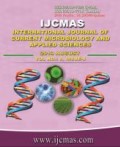


 National Academy of Agricultural Sciences (NAAS)
National Academy of Agricultural Sciences (NAAS)

|
PRINT ISSN : 2319-7692
Online ISSN : 2319-7706 Issues : 12 per year Publisher : Excellent Publishers Email : editorijcmas@gmail.com / submit@ijcmas.com Editor-in-chief: Dr.M.Prakash Index Copernicus ICV 2018: 95.39 NAAS RATING 2020: 5.38 |
Soil transmitted helminths or geohelminths still contribute a major burden to many countries including India. It’s of utmost importance to detect them accurately and timely. Studies on this group of intestinal parasites in adults are rare. Hence, the study explored the usefulness of stool concentration technique and compared them with the direct microscopy for better isolation of the geohelminths in adults. In this study, 254 consecutive stool samples were taken from adult patients of the hospital. Direct and formol ether concentration techniques was performed for each sample and the positive sample smears were stained with suitable stains for proper identification of the parasites. Positivity of egg/ova or adult worm/larva by either method was noted and results were compared and analysed. Of the total 254 samples, 39 samples were positive for an intestinal parasite by concentration method and 22 samples by direct wet mount microscopy. Cohen’s Kappa is 0.686. P value < 0.001. Geohelminths were identified in 23 positive samples. Mixed infection was seen in only 1 sample. Overall, A. lumbricoides (45.23%) was the predominant parasite followed by Blastocystis (21.43%). Comparing these helminths to the other intestinal parasites, its isolation was more (55%) than the other intestinal helminths (45%) thereby indicating its common occurrence in the study population. Female predominance (56%) was seen among the enrolled patients. Better recovery was seen by the concentration technique and hence its detection. Adding this technique over to the direct microscopy will be a useful adjunct to detect and treat patients with low parasite count especially in the immunocompromised population.
 |
 |
 |
 |
 |